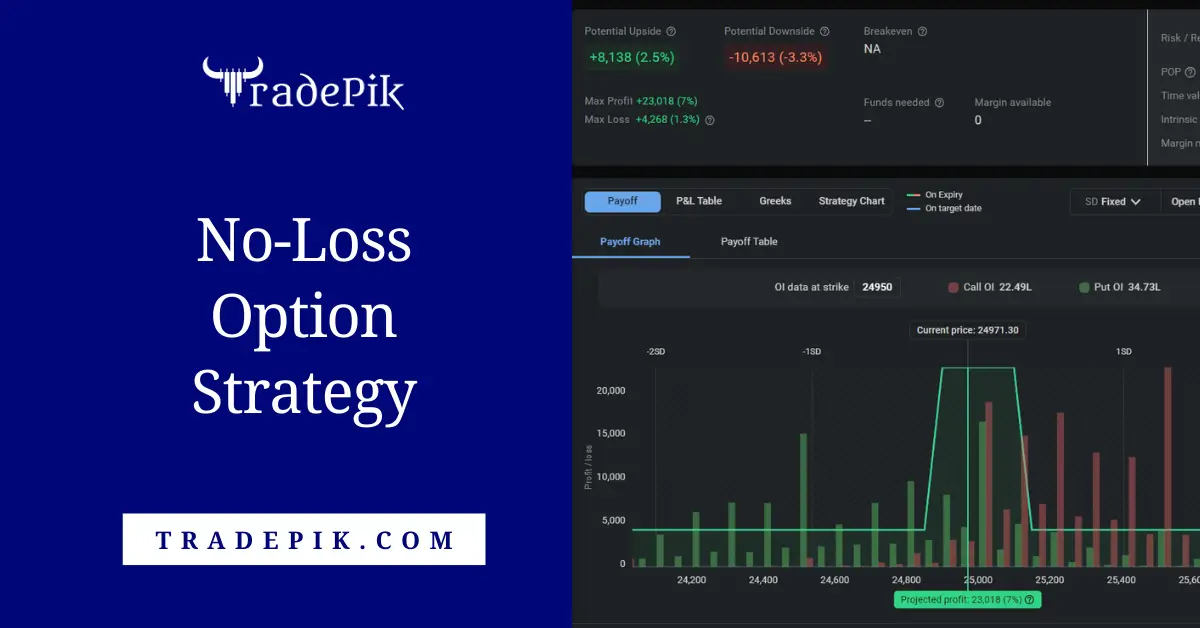No-loss Options Strategy in Nifty: A Step-by-Step Guide
Learn how to create a no-loss options strategy in Nifty with our expert guidance. Discover effective adjustments to minimize risk and maximize returns.

Are you tired of losing money in options trading? Many traders fear the risk of losing their entire investment. But what if there was a way to trade options without the fear of significant losses? In this blog post, we'll explore a powerful strategy known as the no-loss options strategy. By carefully combining call and put options, you can create a trading setup that limits your downside risk while still offering potential upside gains. We'll delve into the specifics of this strategy, including how to choose the right strike prices, adjust for market volatility, and set appropriate stop-loss and take-profit levels. With the right approach, you can potentially achieve consistent returns in the Nifty options market without the fear of significant losses. Let's dive in and discover how to build a no-loss options strategy that can help you navigate the complexities of the Nifty options market.
Understanding Nifty Options
Before we delve into the no-loss strategy, it's essential to have a solid understanding of Nifty options. **Nifty** is the benchmark index of the National Stock Exchange of India (NSE). It represents the top 50 companies listed on the NSE. Nifty options are derivative contracts that give the buyer the right, but not the obligation, to buy or sell the Nifty index at a predetermined price (strike price) on or before the expiry date. There are two main types of Nifty options:
- Call options: Give the buyer the right to buy the Nifty index at the strike price.
- Put options: Give the buyer the right to sell the Nifty index at the strike price.
The price paid to acquire an option contract is known as the premium. The premium is influenced by factors such as the underlying asset's price, time to expiry, volatility, and interest rates.
Building a no-loss options strategy in Nifty
Now that we have a basic understanding of Nifty options, let's explore how to construct a no-loss strategy. This strategy involves combining call and put options in a specific manner to limit downside risk.
The constitution of the no-loss options strategy required 2 steps:
- Step 1: Create a strategy with the combination of call or put or both.
- Step 2: Adjust your strategy in such a way that obliterates the downside risk.
Just look at the below pics:

In the above image, you can see that we don't have any loss on either side. Maximum profit is around ₹23,000 and minimum profit is ₹4200.
We reached at this stage after making some adjustments. Let's talk about these steps in more detail in the next section.
Steps to Create a No-loss Options Strategy in Nifty
As you know we have created this no-loss options strategy in Nifty in 2 steps. Let's come to the first step.
Step 1: Choosing the Right Strategy & Strike Price
The first crucial step is to select the appropriate strategy for Nifty. The strategy should be chosen based on your expectations of the Nifty index's movement.
We were expecting a range-bound movement for Nifty between 24800 and 25200, which is why we chose the iron Condor strategy.
Ideally an Iron Condor and Iron Butterfly are the best strategies to create a no-loss options strategy.
So we have created an iron Condor with the below strikes:
- We have sold 24900 PE & 25100 CE
- We have bought 24700 PE & 25300 CE
- Breakevens are 24800 & 25200. Spread is 200 points.
After creating the strategy, our max loss was around ₹17000 and Maximum profit was around ₹33000 (based on 15 lots & 5 lakh capital).
Now we have to make certain adjustments to convert this strategy into a no-loss strategy.
Step 2: Adjustments for no-loss options strategy in Nifty
To create a no-loss options strategy, adjustments play a crucial role. Without adjustments, it's impossible to create such strategies.
Now to make this strategy a no-loss options strategy, you have to reduce the spread after a certain time and premium.
In the above example, our spread is 200 points. So the calculation of max loss is:
Max Loss = (Spread - net credit received) * lot size
So if we can reduce the spread while keeping net credit received as it is. We can convert our strategy into a no-loss.
So what we did is:
- First, we shifted our bought legs from 24700 PE to 24800 PE and 24300 CE to 25200 CE.
- After some time we shifted our legs from 24800 PE to 24850 PE and 25200 CE to 25150 CE.
After moving our bought strikes to 24850 PE & 25150 CE, we managed to convert our strategy into a no-loss options strategy.
Here we followed the rule of theta decay. This means when the premium decreases by a certain points, we shift our legs.
For better understanding, you can follow it as percentages (%). This means if the premium decreases by 40 - 50%, you can shift your legs.
Please note: We are shifting only the bought legs while keeping the sold legs as it is.
There are some more data points also like OI analysis, iv and chart patterns that we are considering during adjustments.
We teach about these data points in our Mentorship Program and share these strategies along with real-time updates about adjustments in our premium community.
A few important points while following this no-loss options strategy in Nifty:
- Strategy and strike selection is crucial. If you select the wrong strategy or the wrong strike, you will end up losing.
- We prefer only iron Condor or iron Butterfly.
- Keeping your maximum loss on the lower side is also important. Ideally, we prefer 1:1.5 as risk: the risk-to-reward ratio.
Always remeber: Lower the maximum loss, easier to adjust and convert into a no-loss strategy.
- Keep a decent range where the probability is around 45-50%. You can keep a narrow range also if you are creating this strategy 2-3 days before the expiry.
I hope you now have an idea about how to create a no-loss options strategy in Nifty. If you still have any questions, feel free to post them in the comment box.
If you want to learn this along with other option hedging strategies with adjustments, enrol in our "Option Strategies: A Mentorship Program".
In this Mentorship Program, we teach everything from very basics to advanced options hedging strategies with adjustments. Now, after exchanges are closing weekly expiries, it is a good time to create diversification by following these weekly and monthly income strategies.
You can also join our premium community where we share and discuss these trades every month along with timely updates about adjustments.
In case if you have any queries, feel free to type them into comments or contact us.
Have a Profitable trading!





